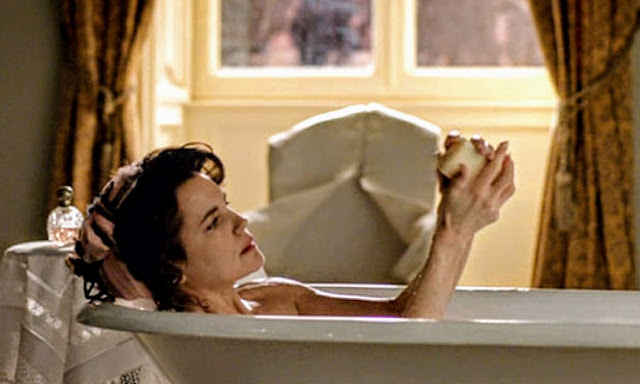 |
| A mere 11 years after the passing of Queen Victoria, the black mourning attire that she had made famous for decades, was being pushed aside and white mourning attire was being promoted. – ‘Only of late years has this spotless garb been taken up for mourning wear; but all white mourning is now considered as correct and as “good form’’ for the deepest mourning as all black —provided the white is of that dull, dead, unglistening sort known as “mourning white.”’ |
TO the woman to whom all black is hopelessly unbecoming white mourning is a veritable boon. Only of late years has this spotless garb been taken up for mourning wear; but all white mourning is now considered as correct and as “good form’’ for the deepest mourning as all black —provided the white is of that dull, dead, unglistening sort known as “mourning white.” This dull white may be obtained in certain serges, silks, and worsted weaves, in silk and wool fabrics, in mohair and wool fabrics and in dull-finished linens. It may not be obtained in satin, in velvet or in broadcloth, these materials being barred to the woman who desires to dress in conformity with the rules of sartorial etiquette.
All white mourning must, however, be absolutely “all white.” One bit of black jewelry; one morsel of black ribbon—even a black boot will render it immediately half-mourning, or second mourning, rather than first or deep mourning as it is intended to be. This picturesque and agreeable white mourning may be worn anywhere in summer time, and indoors in winter time. It goes without saying that the conventional woman would not make a bizarre spectacle of herself by walking down a city street in mid-winter clad from head to foot in snowy white; nor would she enter a restaurant so clad when all the women about her were garmented in dark tailored costumes and furs. In the evening, the white costume would not be as conspicuous—but then the woman in deep mourning is not apt to frequent the restaurants during the gay evening hours.
In the house, however, white mourning is charming and is not only more becoming and dainty than the somber and depressing black, worn for the sake of fitness in the street; but it has a better effect on the nerves and spirits of its wearer and on those of children in the home. The white mourning costume illustrated might be worn with propriety by a very young woman for luncheon or afternoon tea, the white frock being covered with a long white coat for the journey in limousine or taxicab. The frock is of dull white peau de sois with trimmings of white crepe and hand scalloping. The hat of dull white silk is trimmed with white lilacs and white leaves and the white mesh veil with three dull white silk bands is draped in the mourning, fashion. Buttoned boots of white buckskin complete the dainty costume.
Evening gowns of white chiffon, made with many tucks but no other trimming, are ideally graceful and lovely for the wearer of mourning and a string of pearls will add just the right touch of elegance to such a frock. White net and white point d’esprit are also considered correct for morning wear and a young girl in deep mourning may dress in the evening at home in little frocks of tucked or ruffled net, with soft sashes of dull white silk. Such frocks should be modestly cut at the neck and should have long shirred sleeves of the net to the wrist; for upon one thing does convention insist —in the mourning gown– and that is the sleeve to the wrist. An elbow sleeve immediately cheapens a mourning costume and detracts from its dignity and distinction.
White footing is a correct mourning trimming which makes up in its delicate grace for the lace which is barred. Evening gowns of dull white peau de soie trimmed with frills and shirred insertions of white footing are exceedingly dainty, and in summer, dimity and batiste gowns may be as elaborately trimmed with this footing as one desires. Tucks and buttons are two other trimmings allowed to the wearer of mourning and a great deal is made of these trimmings by the clever dressmaker. Huge buttons, covered with the dress material are used with big loops of dull silk, or rows of small crepe covered buttons are effectively placed. Chiffon and crepe de chine frocks and blouses are elaborately tucked, pin-tucks being generously used on the waist and wide horizontal tucks on the skirt; and corded seams and armholes afford another effective trimming to relieve the monotony of the dead white or black.
White serge in a particular dead white weave which comes from mourning use is liked for fall and winter frocks, made along the simple trotteur lines now in favor. Such a frock may have big buttons and loops of dull silk, or buttonholes bound with the silk. The armholes will be corded and if desired, a white leather belt with a pearl buckle may finish the waistline. A huge collar of white crepe with cuffs to match will add much smartness —if crepe is worn. And this white crepe is so beautiful and makes such a rich and effective trimming that it does seem a pity not to make use of it because of a sentiment against the use of crepe in mourning. As a matter of fact, crepe is no more suggestive of gloom than any other mourning fabric and just now it is generously used in all fashionable mourning. A silky weave of mohair with worsted is much liked by the French couturiers for mourning gowns for indoors. This material is trimmed with dull silk or with crepe, and it lends itself most gracefully to the long, clinging lines now favored.
A white gown recently made in New York for a young widow, has a straight, narrow skirt trimmed with two deep ungathered flounces of white crepe, the upper flounce being set on at the hip and the lower one at the knee. The surpliced bodice crosses over a deep vest of the white crepe, crepe buttons and loops outlining the surplice front, and at the back falls a very deep, rounded collar of the white crepe which reaches almost to the waistline. The long, close-fitting sleeves have a line of crepe buttons up the side, almost to the elbow while the gown drags slightly on the floor all around and with it are worn white kid boots with French heels and small white pearl buttons. White Colonial pumps of kid or might be worn with white silk stockings if desired, but the stockings should be plain, and not too thin, with embroidered clocks at the side if desired.
Dull white pongee makes a charming mourning gown for informal home wear and some women like breakfast frocks of dull white linen, made very simply with skirts short enough to show the white buckskin pump or buttoned boot. Crepe is not used on these simple gowns, but a big collar of fine batiste or handkerchief lawn would be in good taste.– Sacramento Daily Union, 1912
Etiquette Enthusiast, Maura J. Graber is the Site Editor for the Etiquipedia© Etiquette Encyclopedia





































